Hops in Beer Brewing: Ivanhoe
Published: October 19, 2025 at 8:49:47 PM UTC
Ivanhoe hops are celebrated for their gentle citrus and pine notes, complemented by a subtle floral-herbal lift. They are reminiscent of Cascade but milder, making them an excellent choice for adding aroma. This versatility ensures they won't overpower the malt or yeast character in your brew.
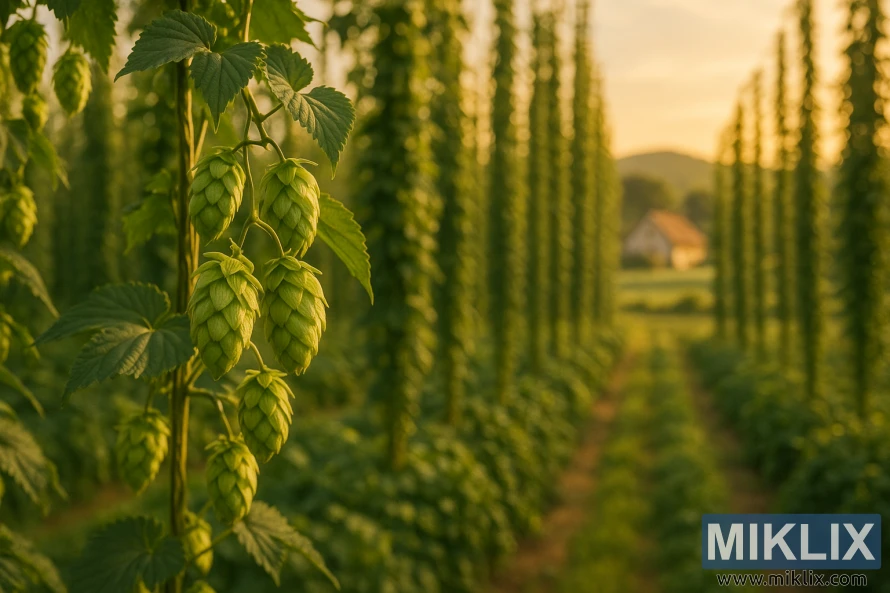
This introduction highlights the significance of Ivanhoe hops in beer brewing. We will explore their origin, chemical and aroma profile, and the beer styles they pair well with. Homebrewers and professionals will find practical advice on sourcing, organic options, dosages, and troubleshooting.
Expect detailed guidance on using Ivanhoe for late additions, dry hopping, and blend strategies. The following sections will examine California Ivanhoe's alpha and beta acid ranges, aroma descriptors, and hop pairings. We'll also share real-world recipes to help you craft distinct, balanced beers using this aroma hops staple.
Key Takeaways
- Ivanhoe hops are an American aroma hop variety with balanced citrus, pine, and floral notes.
- California Ivanhoe is milder than Cascade, suited for aroma-driven late additions and dry hops.
- Use Ivanhoe to add lift without masking malt or yeast character in pale ales and session beers.
- Later additions and dry hopping maximize aroma impact from the Ivanhoe hop variety.
- The article will cover origin, chemistry, recipe guidance, sourcing, and brewer experiences.
Overview of Ivanhoe Hops and Their Origins
Ivanhoe hops represent a concerted effort to revive an old American variety. Their origin is rooted in the California Cluster revival, spearheaded by Hops-Meister, LLC near Clearlake, California. This revival was warmly received by growers and brewers, as California Cluster had been largely absent from cultivation for over 50 years.
The exact parentage of California Cluster remains somewhat of a mystery. Historical records hint at a blend of English and American hop lines. This blend is evident in Ivanhoe, which exhibits both English floral and herbal notes alongside the citrus and pine typical of US hops.
Hops-Meister Ivanhoe is classified as having a more European aroma profile, despite being grown in America. This unique characteristic positions Ivanhoe as a versatile tool for brewers aiming to blend traditional American beer styles with modern, aroma-centric recipes.
In terms of usage, Ivanhoe's hybrid nature shines through. It's commonly employed in American ales, California Common, stouts, and IPAs to enhance floral and citrus flavors. This approach ensures these notes complement the malt and yeast without dominating them. As an early revival of California Cluster, Ivanhoe not only preserves a regional hop heritage but also offers brewers a wide range of aroma options.
Ivanhoe hops
Ivanhoe hops are known for their aroma-focused qualities, not aggressive bitterness. They have a moderate alpha acid range of 7.0–8.0% and beta acids around 4.6%. This makes Ivanhoe a versatile hop for brewers aiming for a balanced aroma without harsh bitterness.
Typically, Ivanhoe is used in late-kettle additions, whirlpool work, and dry hopping. It's often added as a finishing hop or in mixed aroma schedules. This enhances floral, herbal, and soft citrus notes. Single-hop trials frequently highlight its mellow pine and heady floral characteristics, similar to a moderate Cascade.
Recipe databases reveal a wide range in Ivanhoe's application. On average, it makes up about 27% of the hop bill by weight. Usage varies from under 10% in supporting roles to over 70% for single-hop experiments. This depends on the style and desired aroma intensity.
- Role: aroma hop Ivanhoe for late additions and dry hop peaks.
- Flavor cues: mellow citrus, pine, floral, and herbal nuances.
- Alpha/beta: moderate alpha ~7–8%, beta ~4.6%.
When planning a recipe, Ivanhoe will add a soft, rounded citrus top note with piney depth. It's best used where aroma lift is the main goal, not primary bittering. Consider it for pale ales, session IPAs, and hybrid styles that benefit from a gentle floral-herbal profile.
Chemical and aroma profile of Ivanhoe
Ivanhoe's alpha content typically ranges from 7.0% to 8.0%. This range positions the hop as a gentle bittering agent when required.
The beta acid content of Ivanhoe is around 4.6%. This level is crucial for stability and influences the hop's aging behavior in beer.
While exact figures for co-humulone and certain oil fractions vary, Ivanhoe's hop oil composition is significant for its aroma contribution. It plays a more substantial role in the beer's scent than its bitterness.
The aroma profile of Ivanhoe is characterized by a mellow citrus with a pine backbone. It also features clear floral-herbal layers. This profile is often likened to a softer Cascade, making it suitable for English-style and hybrid ales.
Due to its moderate alpha content, brewers often use Ivanhoe in late-kettle additions, whirlpool rests, and dry hopping. These methods enhance the floral-herbal-citrus character. They also ensure controlled bitterness, showcasing the hop's best qualities.
Ivanhoe's practical use is in enhancing aroma. Its controlled bittering and balanced beta acid content make it a reliable tool for modern craft recipes. It's valued for its ability to add depth and complexity to beer without overpowering it.
Beer styles that benefit from Ivanhoe
Ivanhoe excels in beers that require a delicate floral and herbal touch. It's a favorite in American ales for its citrus and pine notes. Brewers often add it late in the boil or as a dry hop. This enhances the beer's aroma without overwhelming the malt or yeast.
California Common beers often include Ivanhoe, thanks to its connection to the California Cluster lineage. It adds a rounded, slightly resinous flavor that complements the lagered body. This makes it a great choice for both historical and modern steam beer interpretations.
In IPAs, Ivanhoe shines as a finishing hop or in dry-hop blends. It brings complexity and subtlety, rather than harsh bitterness. When paired with bolder hops like Citra or Centennial, it enhances the beer's floral-citrus profile.
For stouts, Ivanhoe provides a gentle, pleasant lift that complements the roast malt. Use it sparingly, either late in the boil or as a light dry hop. This preserves the chocolate and coffee notes while adding a herbal touch to the back palate.
- American Ale: late-add and dry-hop for aroma focus.
- California Common: highlight authentic regional character.
- IPA: finishing hop to add complexity in blends or single-hop trials.
- Stout: subtle herbal lift, used sparingly to preserve roast flavors.
Craft brewers often blend Ivanhoe with modern aromatics to craft complex profiles. Its moderate intensity makes it versatile across various beer styles. It's ideal for focused aroma experiments or balanced multi-hop recipes.
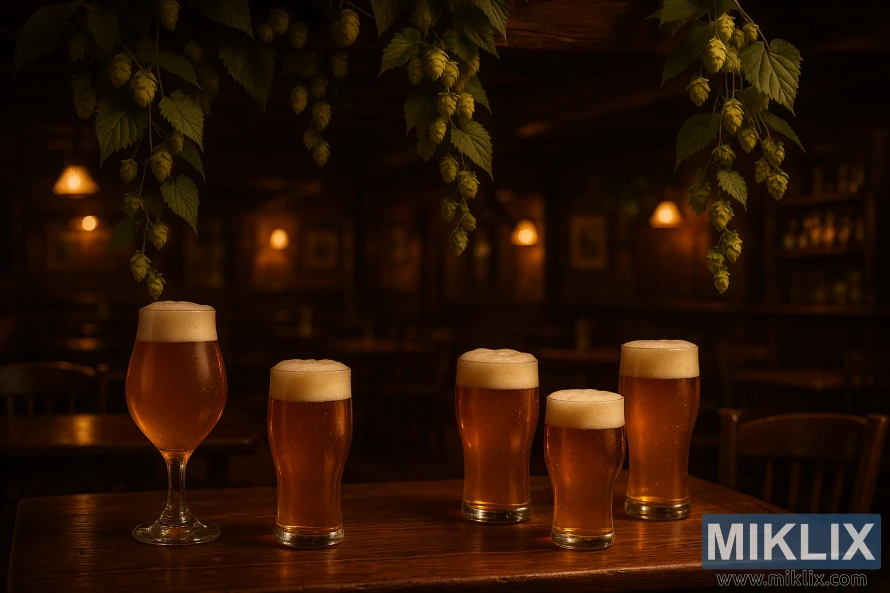
How to use Ivanhoe in recipes for aroma impact
Ivanhoe excels when added late in the brew day. For a bright citrus and floral lift, use late hop additions between 15 and 0 minutes. These hops release volatile oils, contributing citrus, pine, and light herbal notes without harsh bitterness.
For concentrated aroma, try an Ivanhoe whirlpool at 160–180°F for 10–30 minutes. This method gently pulls essential oils, preserving delicate fruit and floral characters. Adjust the contact time to taste; longer steeping increases aroma extraction without significantly raising bitterness.
Dry hopping is crucial. A modest Ivanhoe dry hop charge—around 0.5–1 oz per 5 gal—enhances floral and citrus notes in the finished beer. Many brewers find even stronger aroma when dry hopping in kegs or during cold conditioning.
Be cautious with early boil additions. Ivanhoe’s moderate alpha acids allow it to function as a bittering hop if needed. But early additions will mute its aroma. Reserve most of the hops for late additions, whirlpool, and dry hop to maximize scent.
- Late hop additions: add at 15, 5, and 0 minutes for layered citrus and floral presence.
- Ivanhoe whirlpool: steep at 160–180°F for 10–30 minutes to capture oils efficiently.
- Ivanhoe dry hop: cold-side additions of 0.5–1 oz per 5 gal enhance nose without vegetal notes.
Mind freshness and storage. Older or overdried Ivanhoe can still perform aromatically but may need higher doses. If you want a pronounced nose, combine Ivanhoe with complementary hops or increase dosage to reach the desired intensity.
Trial small adjustments to dosage and timing. Track results in each recipe to refine how to use Ivanhoe hops for the exact citrus, pine, and floral profile you want.
Hop pairings and complementary varieties
Ivanhoe hops are best when they play a supporting, floral role. They act as the glue that holds blends together. Other hops bring bold citrus, tropical, or resinous notes.
Common hops that pair well with Ivanhoe include Cascade, Centennial, Citra, Simcoe, Chinook, Bravo, Nelson Sauvin, Rakau, and Horizon. These combinations are based on recipe databases and homebrew community practices.
- Cascade and Centennial: reinforce citrus and light floral tones for classic American ale profiles.
- Bravo and Chinook: provide clean bitterness plus pine and resinous backbone when you need structural balance.
- Citra, Simcoe, Nelson Sauvin, and Rakau: layer tropical and fruity high notes atop Ivanhoe’s herbal-floral base.
Think of complementary hops as partners in a flavor chorus. Ivanhoe supplies subtle herbal and floral character. Pair it with punchier varieties for more pronounced fruit, dankness, or bitterness.
For a more earthy or grassy nose, match Ivanhoe with hops that emphasize those qualities. If the blend feels too soft, add Bravo to tighten bitterness and clarity without masking Ivanhoe’s perfume.
Recipe builders often split additions: use Ivanhoe in late kettle and dry hop stages for aroma. Mix in Citra or Simcoe for topnotes. This approach highlights Ivanhoe hop pairings while giving each variety room to shine.
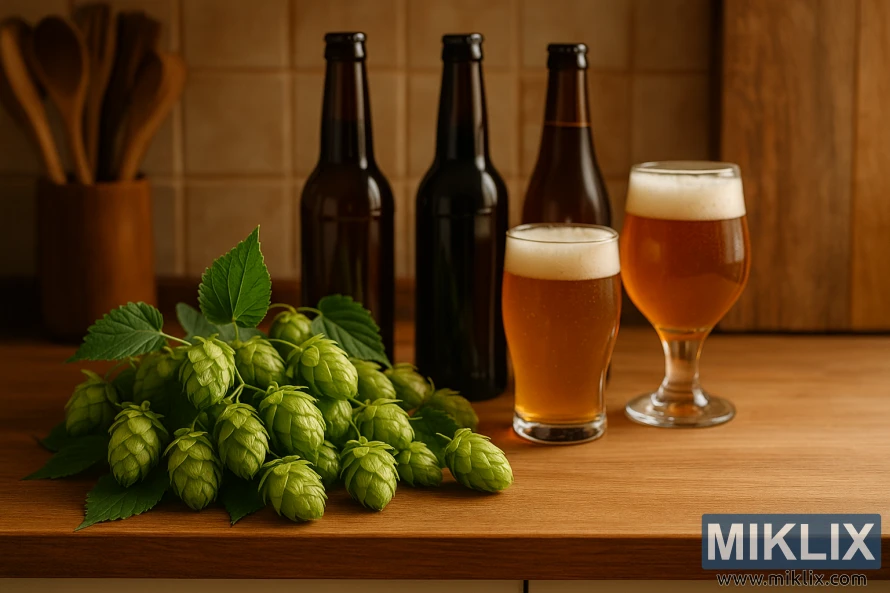
Substitutes and swaps for Ivanhoe in recipes
When Ivanhoe hops are not available, choose substitutes that reflect its California Cluster heritage. Galena, Cluster, and Northern Brewer are top picks. They maintain a strong backbone for bitterness and late aroma.
Galena offers higher alpha acids and a clean, spicy bitterness. It's best for bittering, but use less to match Ivanhoe's moderate alpha acids. Adjust IBUs to avoid over-bittering.
Northern Brewer shares resinous, piney notes, ideal for mid-kettle additions. It balances the malt profile while adding a sturdy herbal character.
Cluster itself is a direct substitute for single-hop recipes. It retains the historical flavor profile, making it a reliable choice when Ivanhoe is scarce.
Cascade and Centennial provide a fruitier, brighter alternative for more citrus or floral lift. Expect a more assertive citrus aroma if you choose Cascade. Reduce late-addition amounts to match perceived intensity.
- For bittering swaps: prefer Galena, but recalc IBUs to Ivanhoe’s ~7–8% alpha equivalent.
- For aroma swaps: use Cluster or Northern Brewer for heritage notes, choose Cascade/Centennial for citrus-forward profiles.
- For single-hop recipes: Cluster is closest; blend with Northern Brewer for structure when needed.
Timing and dosage are crucial. Match late-addition timing and total grams to preserve aroma balance. If using higher-alpha hops, lower the weight and add in stages to tune bitterness and scent.
Keep tasting as you go. Small recipe tests reveal how hops like Ivanhoe translate when swapped, whether you need more floral lift or a firmer piney backbone.
Practical brewing examples and recipe ideas using Ivanhoe
Start with a test IPA to understand Ivanhoe's role in the boil and fermentation. A common example is a 5.5-gallon IPA. It includes 0.5 oz Ivanhoe at 45 minutes, 0.5 oz at 15 minutes, and another 0.5 oz at 15 minutes. The dry hop adds 0.5 oz alongside Cascade and Centennial. This combination results in about 60 IBU, OG 1.073, FG 1.023, and an ABV of nearly 6.5%. It showcases Ivanhoe's floral and citrus notes alongside Bravo and Centennial.
Single-hop trials can isolate Ivanhoe's unique character. Use it as the sole late addition in a pale ale to experience its floral-citrus profile. Its aroma is milder than hops like Citra. For a controlled trial, follow the same process as a standard pale ale but keep late and dry-hop additions modest.
- Suggested starting dosages: 0.5–1.0 oz Ivanhoe per 5 gal for late additions.
- Dry-hop guidance: 0.5–1.0 oz Ivanhoe per 5 gal to assess aromatic lift.
- Scale up in later batches if you want stronger floral or citrus notes.
Blend Ivanhoe into specialty recipes for unique flavors. It's reported to work well in a hibiscus light ale, enhancing floral and tart notes. In a green tea blonde, Ivanhoe adds subtle citrus without overpowering delicate flavors. Some cask brewers use it as a primary hop for a conditionally restrained aroma.
For an Ivanhoe IPA recipe, combine Ivanhoe with classic American bittering hops like Bravo and aroma hops like Cascade and Centennial. Use early additions for bitterness and reserve Ivanhoe for the last 20 minutes and the dry-hop. This preserves its floral-citrus lift.
When crafting an Ivanhoe dry hop recipe, stagger your additions. Add a small amount at high krausen to boost fermentation aroma, then a short cold-side rest addition. This method keeps volatile esters and hop-derived terpenes bright, preventing them from dulling with long warm contact.
Keep detailed records of every variable. Track hop weights, timings, contact time, and temperatures. Small adjustments in dry-hop time or late additions can significantly impact aroma. Use these notes to refine future Ivanhoe recipes.
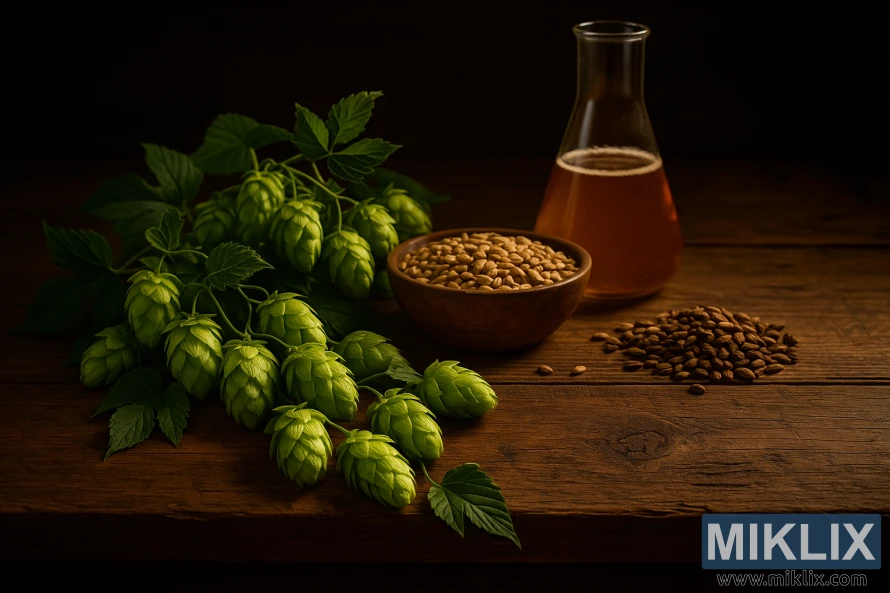
Sourcing Ivanhoe hops and buying organic options
Securing Ivanhoe hops requires more effort than common varieties. Small growers and specialty suppliers dominate the market. Hops-Meister Ivanhoe was instrumental in reviving the variety near Clearlake, California. This effort led to limited batches available for craft brewers and homebrewers.
Specialty vendors list Seven Bridges Ivanhoe as organic whole-cone hops. Community posts and order histories confirm purchases from these suppliers and small organic farms. When seeking organic Ivanhoe hops, verify certification and harvest details before making a purchase.
Availability is seasonal, tied to small harvests. Expect shorter windows and occasional sold-out listings. Some brewers opt for direct purchases from growers like Rising Sun Farms or Flying Squirrel Organic Hops. This approach can yield recently harvested or frozen hops for optimal aroma.
Here are some tips for buying Ivanhoe hops:
- Ask for harvest date and storage method to verify freshness.
- Request organic certification documents if ordering organic Ivanhoe hops.
- Prefer frozen or vacuum-packed whole cones to protect volatile oils.
- Consider small-batch sellers for unique lots like Seven Bridges Ivanhoe.
Shipping costs and lead times may be higher from boutique suppliers. Plan orders in advance to avoid gaps during brew day. For those on a budget, group buys among local brewers help spread cost and reduce per-pound shipping fees.
When sourcing, compare reputation, lot notes, and reviews. A reliable seller will answer questions about crop year, processing, and organic status. This clarity ensures you choose stock that meets your recipe goals and preserves the best aroma when using Ivanhoe in your brew.
Dosage guidance and percentage usage in recipes
Brewers frequently inquire about the appropriate amount of Ivanhoe to use for aroma and balance. For a 5–5.5 gallon batch, a common approach involves small late additions and dry-hop charges of about 0.5 oz each. This method provides a gentle floral lift without overpowering other hops.
Typically, the Ivanhoe percentage in hop bills averages around 27%. Usage can vary from roughly 8.8% to about 75.3% in specialty recipes. This range helps brewers decide whether Ivanhoe will serve as a subtle background accent or a prominent aroma note.
For late additions or whirlpool additions, aim for 0.5–1.5 oz per 5 gallons to enhance aroma and lift. Dry hopping with 0.5–1.0 oz per 5 gallons results in subtle to moderate impact. Increasing the dose can lead to a brighter, more floral profile.
- If Ivanhoe is the primary hop in a single-hop beer, consider using 1–3 oz per 5 gallons, split between late and dry-hop additions.
- When blending, aim to keep the Ivanhoe percentage in hop bill near the dataset average to preserve its character while allowing more assertive hops to take center stage.
- Adjust for freshness; older hops may require a higher Ivanhoe dosage to match the aroma intensity of fresher ones.
Some brewers find Ivanhoe to be quite subtle. For a more pronounced floral nose, consider increasing dry-hop amounts or pairing it with more assertive varieties like Cascade or Mosaic. Small test batches can help determine the right amount of Ivanhoe per batch, taking into account your style and yeast choice.
Keep a record of each trial. Note the total hop weight, the split of late and dry additions, and the resulting aroma. Tracking these details will help refine the ideal Ivanhoe percentage in hop bills for future recipes.
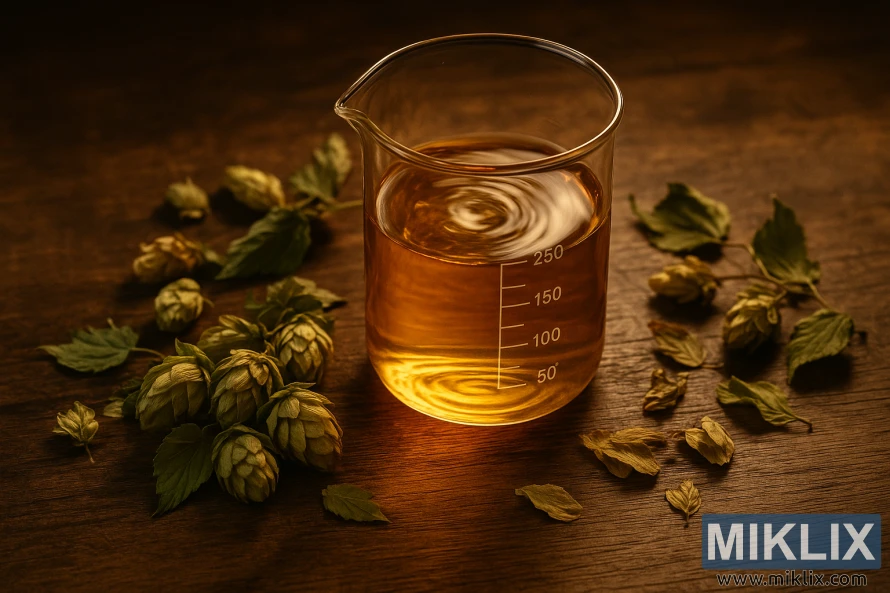
Interaction with yeast and fermentation choices
The choice of yeast significantly influences the presentation of Ivanhoe hops in the final beer. Opting for clean American ale yeasts like Safale US-05 or Wyeast American strains ensures that bitterness remains sharp. This allows the citrus, pine, floral, and herbal notes to shine through. Brewers aiming for a clear beer often select these strains to enhance the hop aroma.
On the other hand, English ale strains such as Wyeast 1968 or Safale S-04 emphasize the hop's floral and herbal aspects. These yeasts produce mild esters, creating a background that complements the English character of Ivanhoe.
Choosing high-ester or phenolic yeasts can overshadow the subtle hop aromas. For Ivanhoe's delicate contributions, it's best to opt for yeasts with minimal ester production. This ensures that the hop's nuances are not overshadowed by fruity or spicy fermentation byproducts.
Controlling fermentation temperature is crucial for preserving hop clarity. Fermenting at a lower-to-mid ale range, around 64–68°F, helps reduce ester production and supports a clean flavor. Warmer fermentations, on the other hand, tend to increase ester production, which can compete with the hop-derived volatile oils.
- Dry-hop timing: add hops near the end of primary or in a short secondary to capture volatile oils.
- Contact time: 5–7 days is typical to extract aroma without harsh vegetal notes.
- Oxygen exposure: limit oxygen during dry-hopping to protect hop aroma and reduce stale oxidation.
Many homebrewers experiment with both English and American ale yeasts when working with Ivanhoe. Recipe databases and community notes frequently highlight these Ivanhoe yeast pairings. This reflects the flexibility in yeast interaction with Ivanhoe, depending on the desired beer style.
When deciding on a yeast strain, consider which one best supports your aroma goals. For a beer with forward citrus and pine, choose a clean American strain. For a beer with floral depth and softer esters, opt for an English strain. Adjusting the pitch rate and temperature can further refine the interaction between yeast and hops during fermentation.
Common issues and troubleshooting with Ivanhoe
Brewers often face issues with Ivanhoe hops during storage and use. Overdrying at the farm or in transit can reduce essential oils, leading to a flat profile. This loss of freshness manifests as a muted aroma, often compared to newer, more aromatic varieties.
When the aroma seems faint, several practical fixes can help. These solutions are designed to address common problems with Ivanhoe hops.
- Increase late additions. Adding more hops in the late boil or whirlpool can enhance aroma.
- Emphasize dry-hopping. A larger dry-hop charge and cooler contact can improve aroma retention.
- Blend strategically. Pair Ivanhoe with assertive varieties like Citra, Simcoe, or Centennial to add citrus and tropical notes.
- Adjust dosage. If hops appear old or overdried, increase the recipe percentage rather than reducing it.
Expectation mismatch is a common issue. Ivanhoe provides floral and herbal notes, not bold citrus like Cascade. To avoid disappointment, treat Ivanhoe as a supporting hop and plan blends around its unique character.
Availability and cost also pose challenges. Limited crops and organic options can be expensive or hard to find. To avoid last-minute substitutions, plan purchases during supplier restocks. Connecting with revival growers or cooperatives can secure fresher lots and better prices.
- Store hops frozen and limit oxygen exposure to protect aroma.
- Source from reputable suppliers and request recent harvest dates when possible.
- When troubleshooting Ivanhoe hops, run small test batches to dial dosage before scaling up.
By following these steps, brewers can address common Ivanhoe hop issues without drastic recipe changes. With fresh material and measured use, Ivanhoe can add a distinctive floral-herbal note to beers.
Brewers’ notes, community experiences, and tasting impressions
Homebrewers and commercial breweries consistently note Ivanhoe's mellow citrus and pine base. They highlight clear floral and herbal notes. Some mention faint apple or pear when blended with Bravo.
Ivanhoe brewer impressions often commend its role in blended IPAs. Brewers praise its pairing with Centennial, Cascade, and Bravo. A notable recipe, Short Nights IPA, achieved 60 IBU with a balanced malt backbone and fresh-hop character.
Ivanhoe community feedback emphasizes its success in dry-hop and cask conditioning. Many call it “lovely” in finished beers. Some samples were slightly overdry but remained aromatic and flavorful.
- Example use: Hibiscus Light Ale—positive results when Ivanhoe blended for floral lift.
- Example use: Main hop in cask beers—praised for classic Californian-Cluster notes.
- Example use: Dry-hop in kegged commercial beers—retained aroma and drinkability.
Pairing Ivanhoe with Bravo reveals a fruity backbone from Bravo. Ivanhoe adds floral and herbal lift. This combination can bring out subtle apple or pear tones in conditioned beer.
Practical takeaway from Ivanhoe brewer impressions and community feedback: freshness and dosage are key. Use moderate dry-hop rates to highlight floral detail without overdrying malt. Brewers seeking a California Cluster character with English floral traits find Ivanhoe reliable.
Conclusion
Ivanhoe hop conclusion: Ivanhoe is a revived California Cluster-derived aroma hop. It offers mellow citrus and pine with floral and herbal lift. Its moderate alpha acids (around 7.3–8%) and beta near 4.6% make it versatile for aroma-focused work. It shines in American ales, California Common, stouts, and can play a supporting role in IPAs when used for late additions and dry hopping.
Should I use Ivanhoe hops? For brewers seeking a balanced, nuanced aroma, the answer is yes—with a measured approach. Use Ivanhoe in late-kettle, whirlpool, or dry-hop additions to preserve its softer floral-citrus character. Start modestly at 0.5–1 oz per 5 gal for late or dry additions, then increase in later batches if you want more intensity or fresher green notes.
Ivanhoe brewing summary: pair Ivanhoe with Cascade, Centennial, Bravo, or contemporary fruit-forward varieties to add complexity without overpowering its signature. Prioritize fresh or frozen hops and consider organic suppliers such as Seven Bridges or Hops-Meister when provenance matters. For practical next steps, brew a small single-hop pale ale or include Ivanhoe as a supporting late hop in an IPA, document dosage and timing, and refine based on tasting notes.
Further Reading
If you enjoyed this post, you may also like these suggestions:
